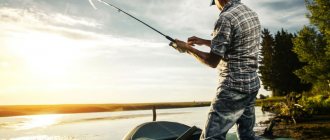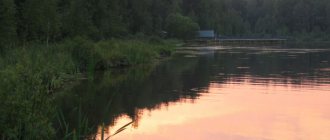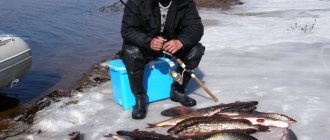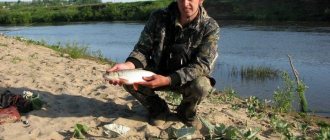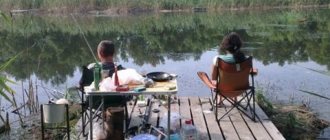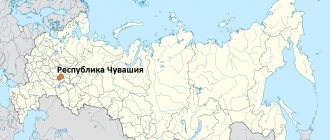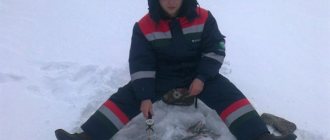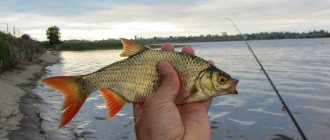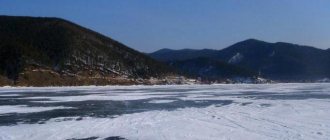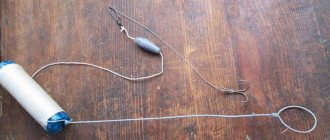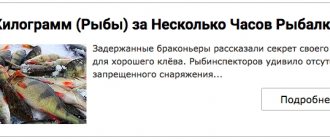Baikal
sevbaikal.ru/tury/rybalka-i-splavy
Who to catch:
grayling, whitefish, omul, lenok, burbot.
When to go:
from January 15 to April 25 - depending on the thickness of the ice.
Tour:
six days. You reach the city of Severobaikalsk, where you are met and taken to the bank of the Tompuda River. Drive UAZ cars across the ice of Lake Baikal, surrounded by endless open spaces and blunders. Warm up in the bathhouse (later it will be regularly included in the program), and the next morning go fishing. Everyone here will have 4-6 holes at their disposal, which will be drilled by instructors. You will always spend the night at the base, and during the day while fishing you can stay warm in a heated trailer house. By the way, it is better to take clothes and shoes for temperatures down to -25°C. It will be possible to purchase hot drinks only in the city before the start of the tour.
Price:
from 39,000 rubles, transfer from and to Severobaikalsk at your own expense.
Lake Onega
karjalapark.ru/content/onezhskay-ribalka
Who to catch:
Onega perch.
When to go:
from January 12 to April 1.
Tour:
three days, two nights. In addition to exciting winter fishing, you can ride through the virgin snow on a snowmobile, learn how to install a real tent (and live in it), and visit the Kizhi Museum-Reserve - the “eighth wonder of the world.” The route will begin in Petrozavodsk and pass through the Nikolsky Strait, Bolshoi Lelekovsky Island, Lyudskoy, the villages of Sennaya Guba and Korba. So you’ll catch a perch and have a cultural rest. And for a long time later you will remember fishing and a serene sleep in a warm, cozy tent.
Price:
from 35,000 rubles. Rental of snowmobiles and a full set of equipment is included in the price. An additional fee is paid for a bathhouse and programs in the kennel of northern sled dogs - Siberian huskies.
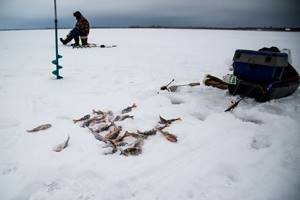
Bosnia, Una river
eklev.ru/bases/lovlya-tajmenya-v-bosnii-na-reke-una.html
Who to catch:
Danube taimen, brook trout, grayling.
When to go:
the season is open from June to February, but the best time is November and December.
Tour:
seven days, six of which are full board and fishing. They will meet you at the airport in Zagreb or Belgrade. By the way, entry is visa-free. The cottage with all amenities and three meals a day will be located on the very bank of the Una River. The place is quiet, almost remote, in the only town on this river there is a shop and a couple of restaurants. The landscapes around will be picturesque - a powerful river, islands, rocks... Fishing is a pleasure! The guide will show and tell you how and what baits are best to catch this or that fish.
Price:
from 41,000 rubles with mandatory support, all necessary licenses, transfers.
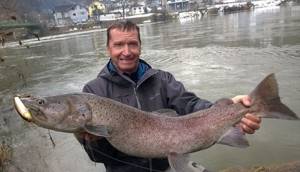
Where to look for fish in the middle of winter?
At this time, underwater inhabitants prefer places with a hard bottom - clay-sand, pebbles, where there are a small number of aquatic plants and a barely noticeable current. At this time, the fish tries to avoid places heavily overgrown with vegetation, where the process of rotting of last year’s algae occurs, which draws out the last oxygen from the water and oxidizes the aquatic environment. These are usually places with standing water and muddy bottoms. Although such areas may be rich in food, you should not look for fish in January and February and hope for an active bite here.
On large reservoirs, the signs of deep winter are least visible. The amount of oxygen in a huge volume of water is enough for a long period. The fish continues to feed all winter, but becomes more capricious and bites cautiously. In the reservoir, unlike rivers, there are no winter parking areas as such - wintering pits. The fish are more evenly dispersed, but still prefer to go to feeding areas that are adjacent to the greatest depths. The temperature of the water at depth is several degrees higher, and it is more comfortable for her to relax and slowly digest her food.
Sand spits with a clear difference in depth and small bushes and snags at the bottom, outlets into bays overgrown with algae, navels adjacent to deep holes are promising places to search.
In rivers, peaceful fish accumulate in huge schools in wintering pits - unique deep places with hard soil and weak currents that form behind water obstacles - mounds, rocks and others. Often in such places, or nearby, there are abundant colonies of shells on the bottom - food for bream, ide and carp. There are few such places in the river. Not every deep hole will be a wintering hole. Fish need several favorable factors for winter “parking”.

Schools of large fish usually accumulate in wintering pits. There may not be room for small items. Small fish are less demanding on wintering conditions. Therefore, roach, dace, perch, etc. are dispersed throughout the river. It can be found in local holes near coastal bushes, in bays where the current slows down and a “return” is formed. In holes next to grass and snags, protected from the current. Right there, next door, a predator is always watching over them.
Large bream and ide can be successfully caught using a combine harvester or winter passes in such places; read the article about this: “Fishing with a combine harvester. Large bream and ide from the ice"
Ural, Vishera River
nordural.ru/tour/zimnyaya_rybalka_na_urale
What to catch:
burbot, pike, perch.
When to go:
end of February-March-April.
Tour:
five days. Guests are met in the city of Krasnovishersk (300 km from Perm), fed and watered, escorted to the bathhouse, and on the second day taken to the village of Sypuchi. They will transport you there and back every day. The guide will tell you everything, show you everything about the gear and habits of the fish, set up a tent for warming, and give you skis. Here they can even set up a personal tent for winter fishing for everyone, just ask. They say that the best fishing is when the river core is already free of ice and only small areas of ice remain along the banks. It is under them that the grayling crowd together.
Price:
from 12,000 to 46,000 rubles. Additional costs may include a license and permit for incidental hunting if the season is open.
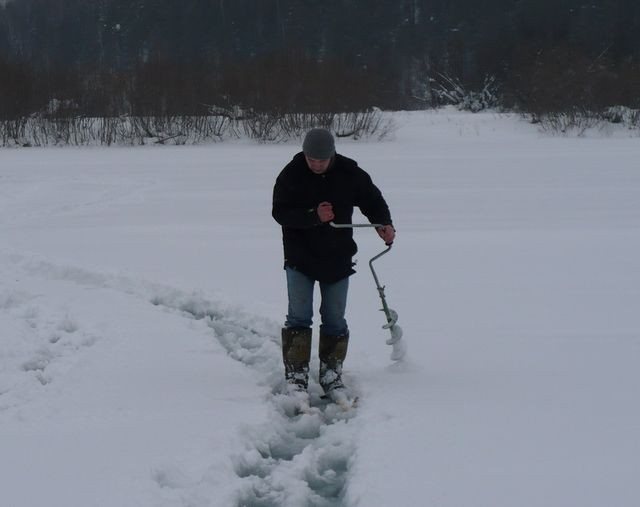
Exploring the coastline
Choosing a place to fish in winter always begins with studying the shore. If it is steep and steep, then the depths should be sought closer to the shore; if it is flat, then further away from it.
Even the nature of the vegetation on the shore matters. If a birch or pine forest borders on a low-growing forest, it means that nearby hard bottom soil is adjacent to soft one.
In general, the fisherman should look for border areas of the bottom where sandstone meets silt, vegetation with a clear place, a hill with a lowland, a flat section of a reservoir with a bay, a rocky ridge or ravine with a plain.
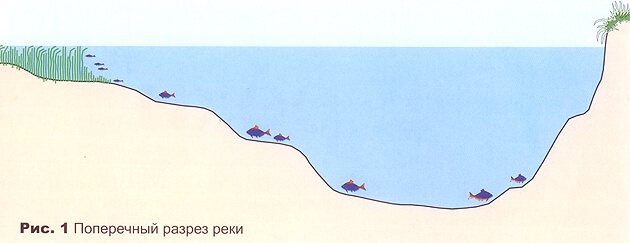
They are always attractive to fish, which, for example, prefer to stay on the sand and feed in the mud, where there are more bloodworms.
Such border zones should be fished first; this is where the fish concentrate. In winter, they can be identified by darker and lighter areas under the ice. Any changes in the bottom should attract your attention; fishing there will always be more successful than in homogeneous areas of the reservoir.
It has long been an established fact that the bite is better where there is a hill on a relatively flat section of the reservoir, where there are snags and large stones, on a steep slope of the bottom, which is directed towards the current.
If, after lowering the jig into the hole, you determine that you are in a place with a hole at the bottom, you know that you are in a place where fish feed.
Chukotka, Lake Mainits.
activetours.ru
Who to catch:
malmu (char), burbot, grayling, pike.
When to go:
April-March.
Tour:
11 days and 10 nights. Arrive in Anadyr, spend the night in a hotel, and the next morning you will travel to the tundra. By the way, this tour is considered extreme in difficulty, and if you want to drive a snowmobile yourself, you will need driving experience. And they will let you drive an all-terrain vehicle anyway. Overnight stays will be organized in a fisherman's house with hot meals and a sauna. In addition to daily ice fishing for different types of fish, there will also be a snowmobile run through the surrounding area and an excursion around Anadyr on the final day of the tour.
Price:
180,000 rubles per person if the trip is by all-terrain vehicle, and 250,000 by snowmobile. The price also includes a pass to the Chukotka Autonomous Okrug.
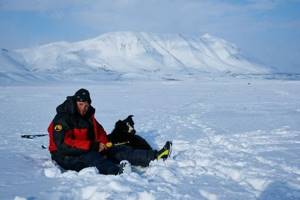
Behavior of fish in the wilderness
The further into winter, the less active and capricious the fish become. First of all, this occurs due to a decrease in the oxygen concentration in the water. The thick ice shell does not allow the reservoir to be sufficiently saturated with oxygen. The fish tries to save as much energy as possible when moving. The energy conservation mode is turned on, and the transition to internal reserves accumulated since the fall is activated. She stops actively moving and feeding.
The less oxygen in the water, the less active the fish. The first to be affected by the wilderness are small, stagnant ponds and lakes with muddy bottoms and abundant vegetation. Oxygen levels drop most quickly there. In the most unfavorable years, starvation occurs - the fish suffocate and die.
In the middle of winter, it is better not to plan fishing on such reservoirs. Look for places where there is a fresh influx of oxygen - springs, springs gushing from the bottom, or small streams flowing into a body of water. Places where there is a moderate current and constant circulation of water masses are better saturated with oxygen. In rivers, fish are more active and tend to move and feed more. Keep this in mind when planning your fishing trip in January.
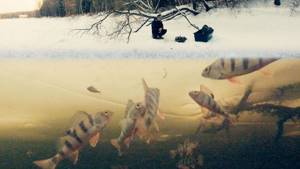
Kola Peninsula, Lovozero
snowtracker.ru/fishing
Who to catch:
grayling, pike, trout, perch and, of course, salmon - the Kola Peninsula is considered one of the best places for salmon fishing.
When to go:
from the beginning of November, but better even from the end of March to the beginning of May.
Tour:
five days.
From Olenegorsk you will be taken on snowmobiles and sleighs to Lovozero. Every day they will organize trips to new places - tundra lakes, mountain rivers. By the way, using a snowmobile makes it possible to get to those protected areas that cannot be reached in the summer. In addition to warm, windproof overalls, a balaclava and ski goggles will be useful in your wardrobe. At the base they will feed you from the belly (rich fish soup made from freshly caught fish - mmmm!), heat a Russian bathhouse, and in the evenings you will see the northern lights against the backdrop of magical white silence. Price:
33,500 rubles, transfer from Murmansk is paid separately.
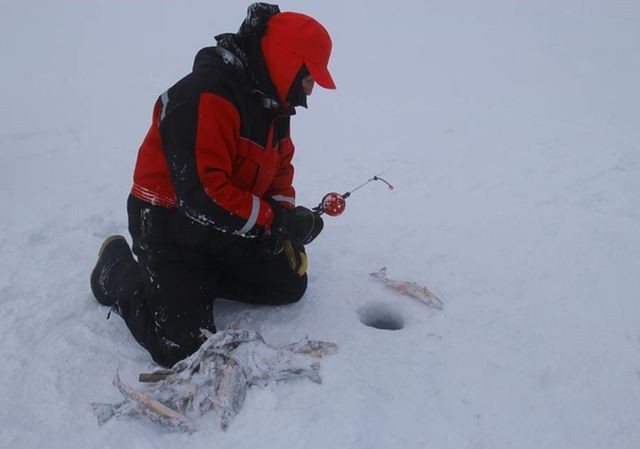
Sweden, Tornio river
worldfishing.ru/spetspredlozheniya/sweden-ice
Who to catch:
trout and grayling, trophy pike and large perch, lake char and whitefish.
When to go:
from March to April.
Tour:
five nights, four days of guided fishing. The small and cozy chalets of the Rajamaa fishing camp are located on a small island right in the middle of the river. Guests are offered full board: breakfast and dinner in the restaurant, a hot camp lunch while fishing, plus a Finnish sauna. Every day you will fish for six hours on different ice lakes on both sides of the Swedish-Finnish border.
Price:
from 68,000 rubles, including transfers from/to Kittila or Rovaniemi airports. The program does not include drinks and transportation to the camp. You need to bring your own gear, but they will provide you with warm clothing.
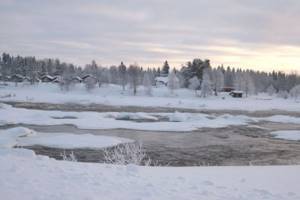
Winter fishing in the Moscow region
Winter fishing in the Moscow region, where to go? What to catch? How to get there? Today we will talk exclusively about winter fishing in the Moscow region. We will answer all your accumulated questions and help you choose a fishing spot.
Fishing in the Moscow region continues all winter. A significant decline in the bite is observed during the low winter season. But even with the onset of this period, you should not throw away your gear, since fishing still continues, just not as actively.
There is an opinion, which cannot but be considered quite probable, that winter hibernation of fish is caused mainly by the lack of air in the water under the ice. L.P. Sabaneev The dry winter period in the Moscow region lasts from mid-January and usually ends at the end of February.
So let's go...
Winter fishing in the Moscow region. Review content:
- Winter fishing in the Moscow region. Lake Senezh
- Winter fishing in the Moscow region. Fish farm "Senezh"
- Trout fishing in winter in the Moscow region
- Fishing in the Moscow region in winter. Podleschik
- Fishing for predator. Pike, pike perch, large perch
- Catching winter roach and perch in the Moscow region
- Fishing in winter in the Moscow region. General recommendations
1
Winter fishing in the Moscow region. Lake Senezh
Lake Senezh in winter
To the north of the ancient town of Solnechnogorsk near Moscow, there is Lake Senezh. It was formed when the beds of the Sestra and Mazikha rivers were blocked by a dam.
This lake, which is essentially a reservoir, is home to fish species familiar to the Moscow region.
- Podleschik
- Zander
- Perch
- Pike
- Burbot
- Gustera
- Bleak
- Ruff
- Acne
Lake Senezh has a special statute for amateur fishing in the Moscow region, which is regulated not by general rules, but by a special regulation of the Ministry of Fisheries of the former USSR. Currently, the fishery industry is doing everything to preserve and increase the fish population of the reservoir.
In winter and summer, the lake is a favorite fishing spot for many anglers in Moscow and the Moscow region.
On Lake Senezh, especially in winter, the most visited places by anglers are the areas around the Senezh fishing farm.
As they say, theater begins with a hanger, but fishing in a cultural fishery starts with the base. And it’s very good when you are greeted at the base by pleasant and friendly people.
2
Winter fishing in the Moscow region. Fish farm "Senezh"
Fishing base Senezh in winter
The fishing base in the Moscow region, Rybkhoz Senezh, has long been the standard for fishermen in Moscow and the Moscow region, among whom it is especially popular. This is a very popular place among Moscow fishermen. There are a lot of fish here and a convenient location.
In the Moscow region there are a huge number of fish farms and private farms engaged in fish breeding and organizing winter fishing in their reservoirs. If the main purpose of fishing is not recreation, but catching a certain amount of fish, then it is better to organize an outing to specialized reservoirs such as the Senezh Fish Farm.
3
Trout fishing in winter in the Moscow region.
We recommend the reservoir Rybkhoz Senezh. Of course, this is not the only body of water where trout is caught in winter in the Moscow region, but there is a lot of it there. The trout population is bred and monitored at the fishery reservoir. The fish farm ponds are regularly stocked with trout. So you are guaranteed successful winter trout fishing.
Predator hunters are frequent guests here.
Senezh often pleases winter fishing lovers in the Moscow region with a good bite. In addition to the always aggressive predators, bream, tench and silver bream are often active on it in winter. The main fish inhabiting the feeding pond are pike, bream, and bream, of which there are a lot here. The most popular and numerous fish that are successfully caught all winter are roach and perch.
Get detailed information about prices, schedules and services.
In addition to trout weighing up to 3 kg in the ponds of the fish farm, the feeding pond is inhabited by:
- Carp, weighing up to 8 kg
- Carp, weighing up to 15kg
- Pike, weighing up to 5 kg
- Perch, weighing up to 500g
What do you use to catch trout and how does the fishing process go, watch the video:
In addition to vouchers for winter fishing in the Moscow region, at the base you can purchase vouchers, bait, and fishing tips. But it’s better to buy bloodworms and live bait in advance for catching predators on the girders.
Tickets can be purchased on weekdays and weekends from 7 a.m. to 5 p.m.
The bite here varies in intensity, but is stable.
4
Fishing in the Moscow region in winter. Podleschik
Fishing in winter in the Moscow region. Podleschik
The first thing to do is to drill the holes correctly, 10 - 15 meters from each other. This is necessary for fishing the area and searching for depth differences.
In search of food, the bream is usually found in places where there are differences in depth, unevenness, snags, edges and holes. In winter, the bream leads a sedentary lifestyle and does not go far from its camp site.
Therefore, when fishing in the winter in the Moscow region, this applies to any body of water; drilling a dozen holes will help you find such places on the body of water. They attract not only white bream.
Choosing tackle for the bream
White bream, like other peaceful fish, is caught in winter in the Moscow region mainly with a jig.
pic Jig for catching white bream
Jigs for catching white bream are distinguished by a forward hook. The shape of the bait should not have sharp corners or edges. Preferred color: black, gray, dark brown.
pic Tackle for bream in winter
Excellent results during active fishing in winter in the Moscow region are obtained by a combination of two baits. The baits are located one above the other. Fishermen in the Moscow region call this equipment “Steam Locomotive”.
pic Passive fishing for bream in winter in the Moscow region
When biting is active, fishermen usually use passive fishing. For passive fishing, use a stationary bait with a guard as a bite alarm.
pic Winter fishing in the Moscow region with currents
When winter fishing in the Moscow region, equipment with a float is more often used. This is especially justified during currents or severe frosts. Correctly configured float equipment is less alarming to the fish when biting.
This is what the jig looks like on the bottom, and this is how the bream takes it...
pic Fishing in winter in the Moscow region. Podleschik
A fishing rod no more than a meter long, equipped with a nod and preferably braid.
The action of the jig is smooth, with a slow rise and a slightly larger amplitude of vibration.
Bream overwinters either in pits, or - even more often - at moderate depths, where the clay bottom is ledges. However, in some places it is very good to catch small bream in winter (using bloodworms). One thing is true that bream do not hibernate, like carp and catfish, and do not bury themselves in the mud, like tench and crucian carp. L.P. Sabaneev
Both bream and bream stay near the bottom in winter, where they feed. Therefore, you need to fish about 60 cm from the bottom. This is approximately three turns of the coil. As bait, you can use bloodworms, worms, crustaceans, mollusks, and insect larvae.
The bream is fed with food bloodworms in winter. This is not always necessary, if you are at the stage of searching for fish, drilling holes, then you do not need to feed the fish, if you have found a school or are fishing in parallel on the girders, you can add a little bait.
5
Winter fishing in the Moscow region. Pike, pike perch, large perch
Catching a predator in winter in the Moscow region
Winter fishing in the Moscow region for predators takes place on zherlitsy. This is the best tackle for winter fishing.
We have already discussed in detail about the designs of winter girders, as well as the technique of winter fishing with girders, in the article “Winter fishing with girders”.
Live bait is used as bait for fishing for girdles in winter. It is best to use the fish that is found in the reservoir in the Moscow region where you fish. This is usually small crucian carp, bream, perch and other small fish. In winter you can buy it at almost all fishing bases in the Moscow region. Or catch it yourself...
6
Catching winter roach and perch in the Moscow region
Roach and perch in winter in the Moscow region
When choosing gear for winter fishing in the Moscow region, you should just arm yourself with various attachments and fishing line thickness.
The thickness of the fishing line used plays a very serious role in fishing. Especially in the Senezh area for roach. It happens that a hundredth of a millimeter can play a serious role in both directions.
As a rule, to catch roach you need to select the thinnest gear. You can stumble upon larger fish, which of course will lead to a break in the fishing line, but this is what gives winter fishing a special thrill. In this case, you need to stock up on various gear to catch larger fish.
A universal and proven bait for winter fishing in the Moscow region is the “devil” jig. Both perch and roach are successfully caught with it.
The jig's performance may differ on different days. To choose the right game, you should first try a smooth game with a jig, if this does not give results, try a faster one.
If various types of wiring and playing do not produce results and the fish cannot be stirred up, change the hole. When leaving to complete the last retrieve, it makes sense to take a short pause and perform a control sweep.
For what? And then that sometimes the fish follows the bait, accompanying it up and down, but does not take it. Fishermen have observed this behavior repeatedly on echo sounder screens. Therefore, the absence of a bite does not always mean the absence of the object of fishing.
When performing a control hook on a pause, it happens that the jig is in the fish’s mouth, but more often there is a ripple behind the lower lip or under the gill cover.
Here is one of the most effective types of jig game without an attachment...
After several low retrieves, which are combined with a fairly high frequency and amplitude of oscillation of the bait, three to four fairly high and slow lifts of the jig are made without playing. This intricate technique very often provokes the fish to bite.
As for depth, fish different layers of water. Most often it is 60 cm from the bottom. For various reasons, the fish can rise and can be found even in half the water.
7
Winter fishing in the Moscow region. General recommendations
The specifics of winter fishing in the Moscow region do not always allow anglers to organize an event on a grand scale. Taking into account the fact that public ponds are always full of people, it is quite difficult to fish a certain area of the reservoir with girders.
Experienced fishermen are well aware of the wintering places of fish in all reservoirs near Moscow, and the concentration of people per square meter of reservoir sometimes exceeds permissible limits.
The most popular gear for winter fishing in the Moscow region are ordinary fishing rods with jigs. For small fish, bloodworms and jigs are suitable as bait, and for hunting large predators, you can use dead fish or live bait.
Flashing also sometimes brings positive results, but most often this method is used at the beginning of winter and after the last ice. At this time, the fish are more active and not every angler will dare to go out on unreliable ice.
Zherlitsy are most often installed by fishermen near Moscow at night. When not one, but several days are allocated for fishing.
But all these are general trends, and each angler has his own preferences and tricks. Wisdom comes with experience.
There are more than 300 fishing bases and farms in the Moscow region. You can view the list of these bases here.
We hope this review was useful to you. Happy fishing!
We look forward to your feedback about fishing on our website.
